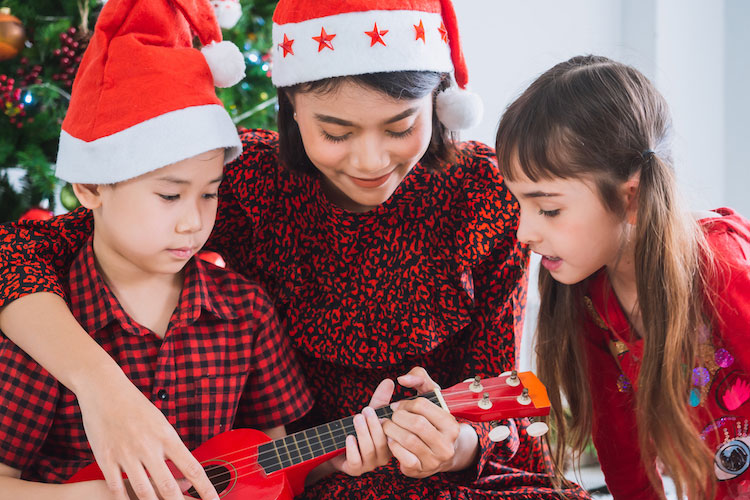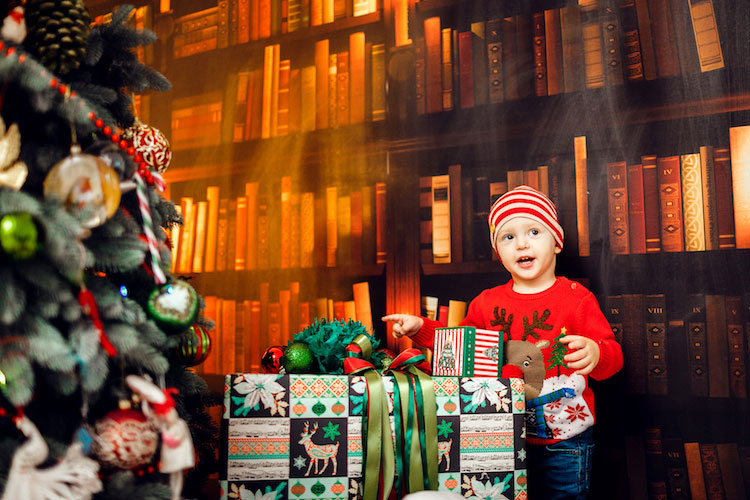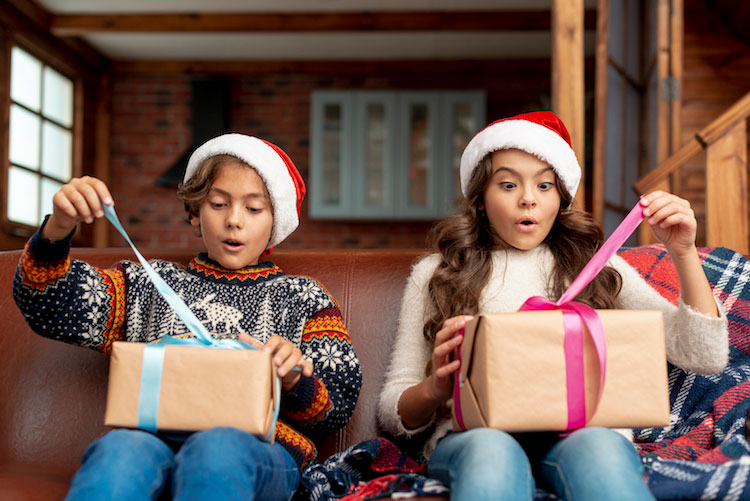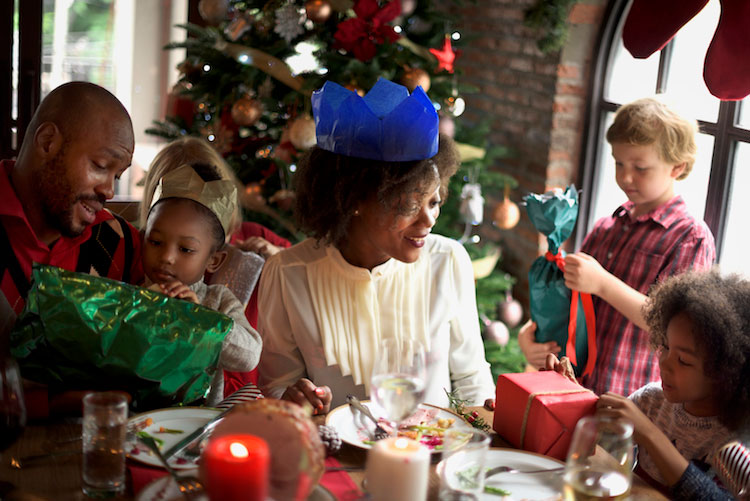


The holidays are here, and for families who have a child or children with autism, gift opening can turn into an unpleasant experience. Parents invest time, thought, effort, and money into making holiday gift opening a fun and memorable tradition. When a family has a child or children dealing with autism, the joy of opening gifts for kids with autism can be squelched by several factors.
This leaves parents, siblings, grandparents, and anyone else involved in the gift opening festivities feeling blue. Here are some tips for preparing your family for successful and fun opening gifts for kids with autism that can be employed regardless of the age of the child.
Bright flashing lights
Loud (unfamiliar) music
Jarring sounds (like paper ripping or other kids squealing)
Powerful odors (scented candles, peppermints, cookies baking)
Overstimulating colors and patterns (bright wrapping paper, people wearing bright colors and/or flashy jewelry)
Multiple activities (people opening boxes, toys being used, television or devices on, music playing, people laughing loudly, pets running around)

Any of these seemingly harmless parts of holiday celebrations can have a devastating impact on someone with autism. Parents and siblings may know with certainty what triggers their family member with autism, or they may not; one has to be a keen observer to figure out the individual triggers. Once they are known, steps can be taken to help the child or teen with autism prepare for and enjoy holiday gift-opening.
So whether chaos is brought on innocently by sensory overload or other factors, there are ways to support a sensitive individual so the whole family can enjoy celebrating and opening presents together. With some forethought and careful consideration using the tips below, the whole family can gather around for a memorable Kwanzaa, Christmas, Hanukkah, Boxing Day, Omisoka, or New Year’s celebration.
Start with a Social Story™ on holidays and/or gift-giving. Keep it simple but broad enough to cover your family’s traditions. Include text and pictures that personalize the routine for your child. Address the things that may trigger the youngster. If you prefer, use the Social Story™ to highlight some coping strategies that may help the child.
Decide on whether your opening gifts for kids with autism will take place indoors or outdoors or both. Knowing this ahead of time will be essential to the overall plan. Refer to the list at the beginning of this article to take into consideration lighting, seating, noise levels, and other details like access to the bathroom. If a family gathering is to take place at someone else’s home, try to find out what the setting will be so you can prepare your child.
It may be helpful to know about the possibility of pets in the room, a fire in the fireplace, ceiling fans spinning, and more before bringing your child there. Another concern when opening gifts for kids with autism in someone else’s home: if your child is on a restricted diet, then make sure to provide treats s/he can have so s/he doesn’t feel left out (or make a grab for “forbidden” goodies).

Is it a family tradition to open gifts in the morning while wearing pajamas? Since this may be quite out of the ordinary, a trial run before the actual holiday might be in order. See how it goes by having a couple of wrapped boxes in the room on a regular weekend morning to practice opening. This might be a good technique for identifying triggers.
Can the special needs child have his/her gifts wrapped in paper that mean something to the child? It might be smart to have all the presents for that child wrapped in the same paper. Alternatively, if the wrapping paper is not right for the child, consider gift bags in the same design or color for easy identification.
In a room full of brightly wrapped gifts, it may prove confusing for the child to know which are his/hers and which belong to others. There’s always the option of presenting a gift to the child with no wrapping at all. If it works, go with it.
Perhaps a visual schedule of some kind would guide the child through gift opening. Depending on the child’s comprehension, you could do a simple five step schedule or a lengthier ten or twelve step schedule. Include pictures to show the process and simple text to explain each step. If necessary or supportive, make the schedule editable to provide flexibility at the moment.
[bs4
Another idea is to have the child with autism play a certain role in gift opening, and “train” them ahead of time so they know what to do. Perhaps the child/teen can be the one who hands out presents to everyone. Or maybe the child helps stack each person’s gifts next to them after they are opened. Got a kid who likes to clean up? Maybe they help dispose of used wrapping paper. Get creative and help them stay grounded with a “VIP” (very important project).
Is gift opening a free-for-all or a take-your-turn event? Think about what might help the child enjoy the tradition and go with that. Other family members may have to adjust their preferences, but measuring the risk vs. reward could mean the difference between a successful gathering or a disappointing one. All year round, there are great opportunities for practicing how to take turns.
In fact, an ABA program at school or at home can address the process of receiving and opening gifts. One technique for a take-your-turn event is to have the person whose turn it is wearing a special hat. This serves as a visual cue for the child with autism and sets a guideline to help them feel comfortable.

It wouldn’t be a bad idea to have a plan for a meltdown. If the family is aware one could happen during a fun family event like a gift opening and is prepared for how to respond, the chances of salvaging the affair increase. Try to prevent a meltdown from ruining the entire occasion; there’s nothing wrong with taking a break and resuming the fun later in the day. If a meltdown occurs, bring out the Social Story™ to serve as a reminder about what is happening.
Returning to the sensory aspect of gift opening – the child with autism might like to wear noise-reducing headphones for the event. S/he may feel good sitting on a wobble disc or ultra soft cushion. Maybe a large exercise ball would do the trick! Or how about having a basket of fidgets nearby? Chances are, the person with autism wouldn’t be the only one playing with those fidgets!
Finally, remind everyone in the family to be flexible. This is particularly important for younger children who may not have had years worth of gift opening experiences. A family may have to make exceptions to the way things usually go in order to accommodate the child/teen with autism. And that’s okay.
Make your gift opening party go very quickly, or slow things down by a lot! Spread it out over an entire day, or make it last several days. Be willing to coach others before, during, and after the event, especially if they are not around your child often. Keeping the mood calm and light (neutral) may be key to helping the child/teen with autism enjoy their holiday gifts.
Last, if it is important to the family, have a game plan for saying thank you. Some families get physical with hugs and kisses after sharing presents. Some sing. Some may dance. Others may clink glasses and partake in delicious treats.
Think about what ends the gift opening and make a plan for that as well. If the child is nonspeaking, maybe a communication device will allow the child to express thanks. A PECs card can be used as well. Or, a simple high five or fist bump might suffice.

In the case of a child/teen who really gets into it and doesn’t want gift opening to end, count your blessings, and then have a strategy for transition. It might be enough to direct the child’s attention to one of his/her gifts. Don’t forget the magic of a two-minute warning if it appears that your child is having so much fun s/he doesn’t want to stop. If using a schedule, make sure there is an icon to indicate that the gift opening is over. Have something preferable for the child to engage in afterward.
When it comes to opening gifts during the holidays with a child or teen with autism, anything can happen. Know your child well, and devise a plan to cover all aspects of the event. Don’t put pressure on anyone. Be willing to go with the flow and be flexible. Finally, although it might sound contradictory, lower your expectations. It does not have to be perfect.
The unexpected can and does happen. That is living with autism. Hoping that “nothing bad will happen” is not a plan. Take time to think about and employ a plan, and Christmas/Kwanzaa/Hanukkah/Omisaka gift opening gatherings will provide a family with treasured memories.
Check out more of our Special Needs Category blog posts. You can also find out the upcoming events for kids in the Sacramento area.
Just enter your email address below and you’ll get an email every time we publish a new post!
Categories :
Tags :
Keri is a special needs parent and a veteran high school English and journalism teacher turned writer. She enjoys reading, hiking, gardening, cooking, traveling, wine tasting, and practicing yoga. Both she and her son love to create art. She has a passion for educating people on all things autism. Visit her blog at https://kerimehome.com.
View All PostsNotifications